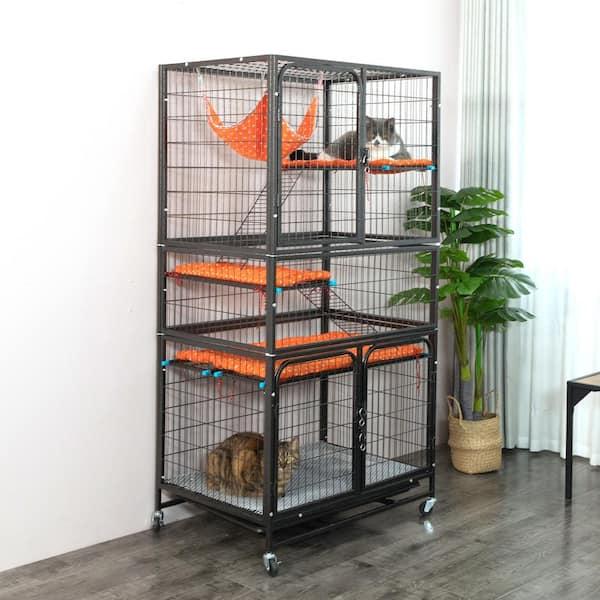Welcoming a cat into your home brings an abundance of joy and companionship. However, there may come a time when you need to consider the use of a cat cage to ease transitions, manage behaviors, or ensure safety. Whether you are introducing a new feline friend, like the crate method suggested by pet communities, or adhering to expert advice on temporary confinement, understanding the ins and outs of caging your cat is essential. Our comprehensive guide will explore various scenarios where using a cat cage can be beneficial, debunk myths, and offer practical tips to make the experience stress-free for both you and your furry companion. Let’s delve into the world of cat cages and discover why and when they might just be the perfect solution for your pet-care needs.
Table of Contents
- Choosing the Perfect Cat Cage for Your Feline Friend
- Essential Features to Look for in a Quality Cat Cage
- Creating a Cozy and Safe Environment Inside the Cat Cage
- Tips for Maintaining and Cleaning Your Cat Cage Effectively
- Q&A
- To Conclude

Choosing the Perfect Cat Cage for Your Feline Friend
Finding the ideal cat cage for your beloved pet involves considering several factors to ensure comfort, security, and convenience. When choosing the perfect cage, keep in mind your cat’s specific needs and preferences, as well as the cage’s functionality.
Firstly, size matters. Your cat must have enough space to move freely, stretch, and play. The cage should be large enough to accommodate:
- A cozy sleeping area
- A litter box
- Food and water dishes
- Toys and scratching posts
For larger breeds or multiple cats, consider opting for a multi-level cage that offers additional vertical space.
Material and construction are also crucial factors. Look for cages made from durable, non-toxic materials. Metal cages with a rust-resistant coating are ideal for durability, while plastic bases can simplify cleaning. Ensure the cage has secure latches and doors to prevent escapes. Ventilation is vital, so choose a cage with ample airflow provision to keep your feline friend comfortable.
Portability and storage should not be overlooked. If you travel frequently or need to move the cage around your home, opting for a foldable or lightweight cage is beneficial. Some cages even come with wheels for enhanced mobility. Additionally, consider a cage with removable, easy-to-clean parts to maintain hygiene effortlessly.
| Feature | Consideration |
| Size | Spacious for activity, multi-level for multiple cats |
| Material | Durable, non-toxic, easy to clean |
| Ventilation | Ample airflow |
| Portability | Lightweight, foldable, wheeled |
Lastly, focus on additional features that enhance your cat’s experience. Some cages come equipped with built-in shelves, hanging toys, or even hammocks for added comfort and entertainment. By prioritizing these key elements, you can ensure you are providing a cage that not only meets your feline friend’s practical needs but also offers a secure and enjoyable environment.
Essential Features to Look for in a Quality Cat Cage
When selecting a high-quality cat cage, there are several essential features to keep in mind to ensure the utmost comfort and safety for your feline friend.
Materials and Construction
A top-notch cat cage should be crafted from durable materials that can withstand wear and tear. Look for cages constructed from premium-quality finished metal mesh, as these provide robust security while allowing adequate ventilation [[3]].
Ease of Cleaning
Maintaining hygiene in your cat’s space is crucial. Opt for cages that feature removable trays or panels for easy cleaning. These elements simplify the process of getting rid of waste and other debris, ensuring a sanitary environment for your pet [[2]].
Mobility and Accessibility
Cat cages equipped with wheels can be moved effortlessly, allowing for convenient relocation within and outside the home. Additionally, the cage should have multiple access points—doors and sliding panels—that provide easy access for feeding, cleaning, and playing with your cat [[3]].
Space and Customization
A spacious cage is vital for your cat’s comfort. Ensure the cage offers ample room for a litter box and other essential items, like bedding and toys. Some models even allow for customization and expansion to cater to your specific needs. Here is a comparison of different size options:
| Size | Dimensions | Best For |
|---|---|---|
| Small | 24″x18″x20″ | Kittens |
| Medium | 36″x24″x28″ | Single Adult Cat |
| Large | 48″x32″x36″ | Multiple Cats |
By focusing on these key features, you can find a cat cage that not only meets your feline’s needs but also makes your caregiving tasks simpler and more efficient.

Creating a Cozy and Safe Environment Inside the Cat Cage
Ensuring your cat feels comfortable and secure inside the cage is paramount. Start by selecting a cage that’s appropriately sized — not too cramped, yet snug enough to offer a sense of security. Inside, create a soft and inviting bedding area using plush blankets or a small cat bed. This gives your feline a cozy spot to rest and reduces stress during travel or temporary confinement.
- Bedding: Use washable, soft blankets or a cat bed.
- Hideouts: Place a small box or cat hideout to allow your pet to retreat and feel safe.
- Toys: Include a few of your cat’s favorite toys to keep them entertained and comforted.
- Litter Box: For larger cages, adding a small litter box in a corner can be a game-changer, especially for extended stays.
Keep the environment calm, quiet, and familiar. Familiar scents can dramatically improve your cat’s comfort levels. Try adding an unwashed item of your clothing or spray synthetic feline pheromones inside the cage to help reduce anxiety. Position the cage away from heavy foot traffic and noise to maintain a serene atmosphere.
Here’s a quick guide to essential items and their benefits:
| Item | Benefit |
|---|---|
| Soft Bedding | Comfort and warmth |
| Hideout Box | Security and privacy |
| Interactive Toys | Engagement and soothing distraction |
| Litter Box | Hygiene and convenience |
| Familiar Scents | Reduced stress and anxiety |
Lastly, ensure good ventilation and temperature control. Keep the cage in an area where there’s ample airflow but avoid direct drafts or placing it in extreme temperatures. You can also drape a lightweight blanket over part of the cage to create a safe cave-like feel while still allowing for proper ventilation.

Tips for Maintaining and Cleaning Your Cat Cage Effectively
Ensuring your cat’s cage remains clean and well-maintained is fundamental to your feline friend’s health and happiness. Start by establishing a cleaning routine. Daily spot cleaning is crucial to prevent the build-up of dirt and bacteria. Remove any visible waste, replace soiled bedding, and wipe down surfaces with a pet-safe disinfectant. To avoid any harmful residues, make sure the cleaning product is fully rinsed off before letting your cat back into the cage.
Deep cleaning should be performed weekly. This involves taking out all removable parts, such as litter boxes, food dishes, and toys, and washing them thoroughly. For plastic components, a solution of warm water and mild soap will suffice. Metal parts can be treated with a water and vinegar mix to disinfect and remove any spots or odors. Always ensure the items are completely dry before reassembling.
Maintaining your cat’s cage also means making sure it’s a comfortable and stress-free environment. Regularly check for signs of wear and tear, such as frayed edges or loose wires, and repair them promptly to prevent injury. Adding soft bedding not only provides comfort for your cat but also absorbs any mess, making it easier to clean during your daily spot clean routine. Rotate the bedding materials to keep the cage smelling fresh and to give your pet a variety of textures to enjoy.
Consider the following maintenance checklist to keep everything in order:
| Daily Tasks | Weekly Tasks |
|---|---|
| Spot clean surfaces | Deep clean cage |
| Replace soiled bedding | Wash removable parts |
| Refresh water and food bowls | Inspect cage for damage |
| Remove waste | Rotate bedding materials |
Lastly, it is also beneficial to watch for behavioral cues from your cat that may indicate their comfort or discomfort levels. If your cat seems stressed or reluctant to use the cage, it might be time to reassess its cleanliness or setup. By following these tips, you can ensure that your cat’s home is both hygienic and welcoming, fostering a happy and healthy environment.
Q&A
Q&A: A Closer Look at Cat Cages
For cat owners, ensuring the well-being and safety of their feline friends is a top priority. Whether you’re dealing with transporting your pet or providing a temporary enclosure, cat cages serve various purposes. In this Q&A, we explore some common questions and insightful answers about cat cages.
Q: What are the primary uses of a cat cage?
A: Cat cages are incredibly versatile. They’re primarily used for travel, especially when you need to ensure your cat’s safety in a vehicle or on public transport. They are also beneficial for veterinary visits, allowing for secure and stress-free trips. Furthermore, cat cages can serve as temporary enclosures during training, illness recovery, or to separate your cat from potential household hazards.
Q: How big should a cat cage be?
A: The size of a cat cage should provide enough room for your cat to stand, turn around, and lie down comfortably. For short trips or brief stays, a smaller cage might suffice. However, if your cat will spend more than a few hours in the cage, it’s crucial to opt for a larger size, giving them ample space to stretch out and even move around a bit.
Q: What are some features to look for in a good cat cage?
A: A quality cat cage should be sturdy and well-ventilated to ensure your cat’s comfort. Look for cages with secure latches and escape-proof designs. Features such as removable and washable trays, soft bedding, and easy access doors can add to the cage’s practicality and your cat’s comfort. It’s also beneficial if the cage is foldable for convenient storage when not in use.
Q: Are there any tips for getting a cat accustomed to a cage?
A: Introducing your cat to a cage should be a gradual process. Start by leaving the cage open in a familiar environment with some of your cat’s favorite treats, toys, or a cozy blanket inside. Allow your cat to explore at their own pace. Positive reinforcement, like treats and praise, can encourage them to associate the cage with a safe, pleasant experience. Never force your cat into the cage, as this can create anxiety and resistance.
Q: How long can a cat safely stay in a cage?
A: The duration a cat can safely remain in a cage depends on the cage’s size, the cat’s comfort, and their individual needs. For short trips, it’s generally fine to cage your cat for a few hours. For longer periods, such as during travel or medical recovery, ensure the cage is spacious enough for them to move comfortably and include breaks if possible. It is not advisable to leave cats in a cage for extended periods unless absolutely necessary and you have taken steps to make the environment as comfortable as possible.
Q: What are some common mistakes to avoid when using a cat cage?
A: One common mistake is selecting a cage that’s too small, as cramped spaces can create significant stress and discomfort. Another mistake is not securing the cage properly during travel, which can result in dangerous situations. Ensure that all latches are securely closed and that the cage is stable. Lastly, never use the cage as a punishment tool, as this can create a negative association and make future caging attempts much more challenging.
For more insights and tips on feline care and related accessories, be sure to check out further resources and expert advice available online.
To Conclude
creating a comfortable and safe environment within your cat cage is essential for the well-being of your feline friend. Whether you’re looking to introduce a new kitten gently, eliminate lingering unpleasant odors, or simply make your pet feel at ease, the right approaches and materials can make a significant difference. Remember, a well-maintained cat cage not only promotes better health for your cat but also contributes to a harmonious living space for both you and your pet. By paying close attention to your cat’s specific needs and preferences, you’ll foster a happier, healthier relationship with your furry companion.
If you have any tips or experiences you’d like to share, feel free to leave a comment below. We would love to hear from you!
For more detailed advice and expert insights on pet care, make sure to explore our other articles.







0 Comments